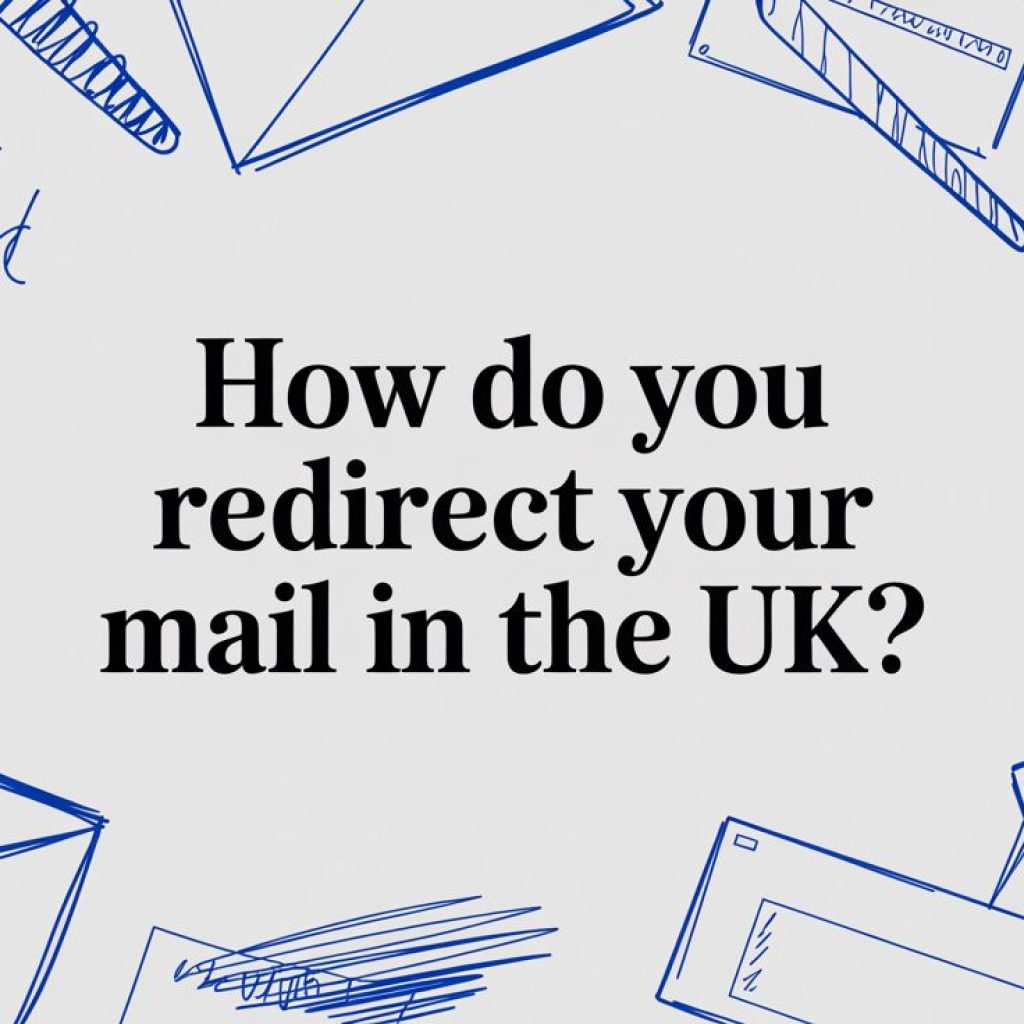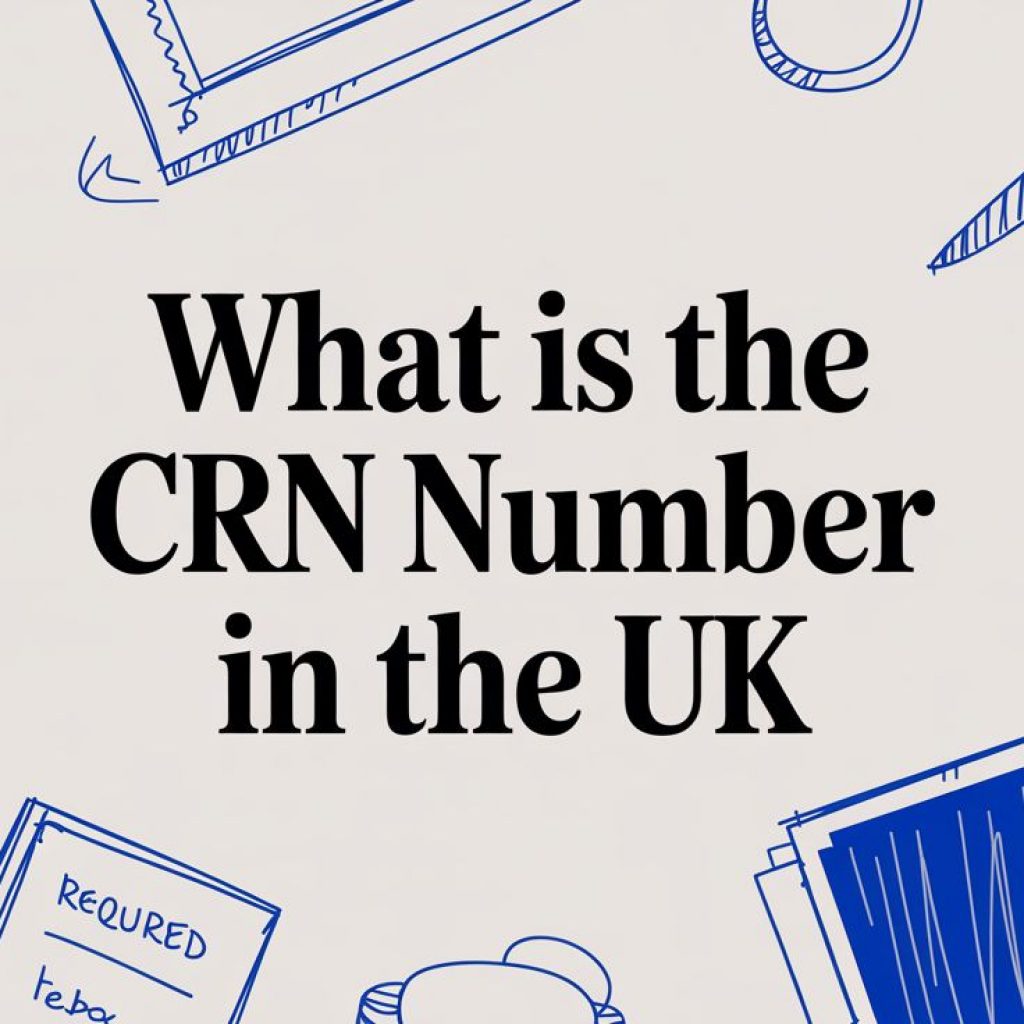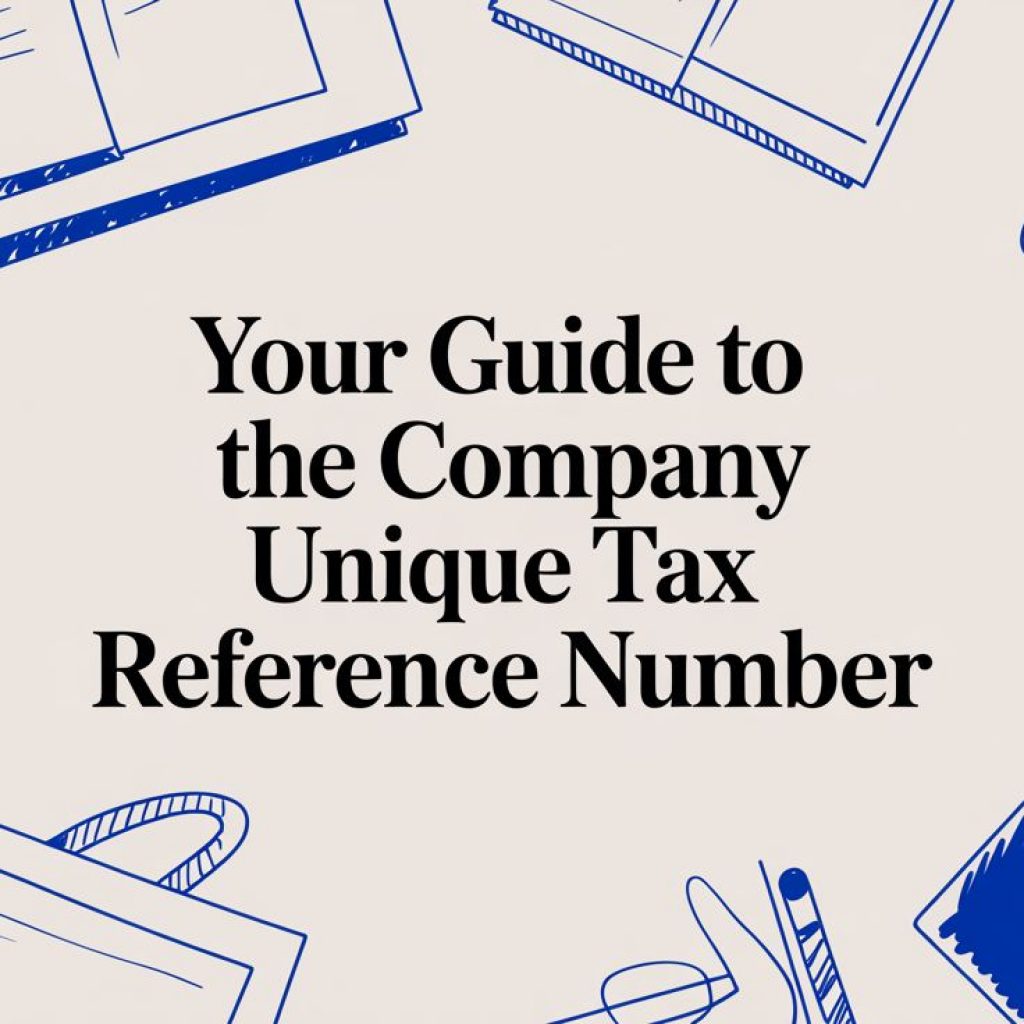When Do You Need to Be VAT Registered?
Right then, let’s talk about the big number that every growing UK business needs to keep on its radar: £90,000. Crossing this line is the trigger for mandatory VAT registration, and it’s not based on your tax year or the calendar year.
Think of it as a rolling 12-month window. You need to constantly look back over the last 12 months of trading to see if your sales have tipped over that magic number. Once they do, the clock starts ticking.
The £90,000 Signal: When You Must Register for VAT
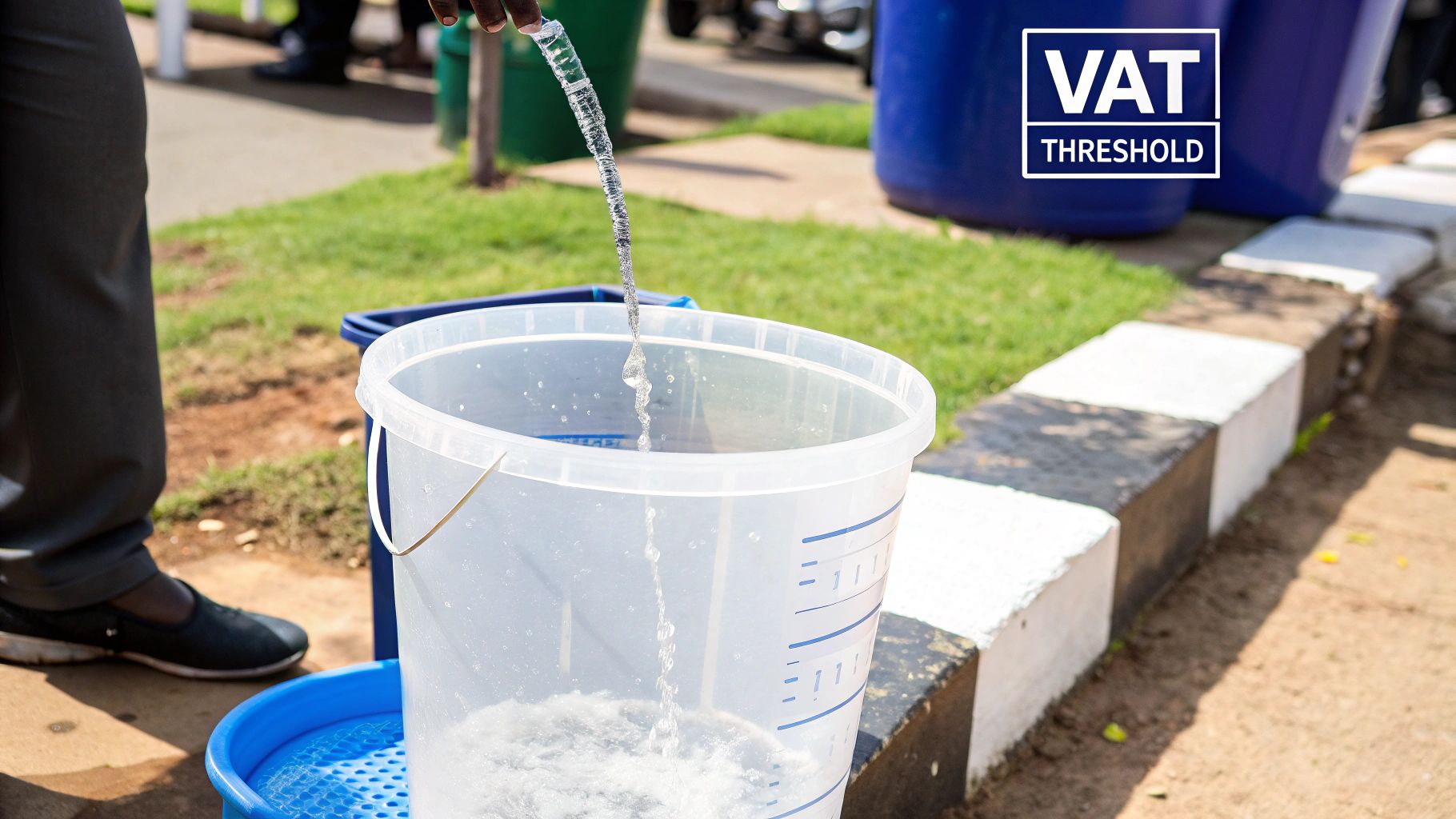
Knowing exactly when to register for VAT really boils down to one key figure. This is the main tripwire for compulsory registration, and keeping a close eye on your turnover is a non-negotiable part of running a growing business in the UK.
As of 1 April 2024, the threshold was bumped up from £85,000 to £90,000 – the first increase in quite a while. This means any UK business with a taxable turnover that goes over £90,000 in any rolling 12-month period has to register with HMRC. You can read up on the specifics of the threshold increase on the official government website.
To make things crystal clear, here’s a quick summary of the essential figures and deadlines.
VAT Registration Quick Facts
| Key Element | Details |
|---|---|
| Mandatory Threshold | £90,000 in a rolling 12-month period |
| Effective From | 1 April 2024 |
| Previous Threshold | £85,000 |
| Registration Deadline | Within 30 days of the end of the month you exceeded the threshold |
| VAT Charging Start Date | From the first day of the second month after you go over |
This table gives you the at-a-glance details, but the real key is understanding what makes up that £90,000 figure.
What Is VAT Taxable Turnover?
The crucial term here is VAT taxable turnover. This isn’t your profit or even your total sales revenue. It’s the total value of everything you sell that isn’t specifically exempt from VAT.
Imagine your turnover is like water filling a bucket. Once it overflows that £90,000 line, you’re legally required to act.
To get this figure right, you need to add up all sales from:
- Standard-rated goods and services: This is most things, from your consulting fees to the electronics you sell.
- Reduced-rated goods and services: Think things like children’s car seats or domestic fuel.
- Zero-rated goods and services: This covers most food, books, and kids’ clothing. Even though the VAT rate is 0%, the value of these sales still counts towards your turnover!
Understanding What to Exclude
Just as important is knowing what not to count. If your business only sells goods or services that are VAT-exempt—like insurance, certain financial services, or some types of medical care—then you cannot register for VAT at all.
This is a critical distinction. Lumping all your income together without separating the exempt items is a classic mistake.
A common pitfall is tracking total sales instead of focusing purely on VAT taxable turnover. This can lead to registering for VAT too early or, much worse, miscalculating and registering late, which almost always comes with penalties from HMRC.
By getting a clear picture of what counts towards the £90,000 threshold, you can stay in control of your finances and know exactly when it’s time to take that next step.
Calculating Your Turnover the Right Way
Getting your head around your VAT taxable turnover is the single most important step in figuring out if you need to register. This isn’t just about glancing at your annual sales figures; it’s a specific, ongoing calculation that you need to stay on top of.
The key concept here is the rolling 12-month period. Forget your standard financial year or the calendar year for a moment. Instead, picture a continuous window. At the end of every single month, you need to look back over the previous 12 months and add up all your relevant sales. Doing this simple check each month means you’ll never be caught out by a surprise VAT bill.
What to Include in Your Calculation
Your VAT taxable turnover is the grand total of everything you sell that isn’t VAT-exempt. Nailing this calculation is vital for staying on the right side of HMRC.
So, when you’re adding things up, you must include the value of:
- Standard-rated goods and services: This is the bread and butter for most businesses, covering everything from consultancy fees to things you sell in a shop.
- Reduced-rated items: Think things like domestic fuel or children’s car seats.
- Zero-rated items: This is the one that often trips people up. It includes sales of things like most food, books, and kids’ clothing. Even though the VAT rate is 0%, the value of these sales absolutely counts towards that £90,000 threshold.
Keeping clean, meticulous records of these sales is non-negotiable. For a bit more on why this matters so much, you can explore the importance of keeping accurate accounts to keep your business on solid footing.
What to Exclude from Your Calculation
Just as important is knowing what to leave out of the maths. If you accidentally include income that isn’t taxable for VAT, you could end up registering (and charging your customers VAT) long before you legally have to.
Make sure you exclude these from your turnover calculation:
- VAT-exempt sales: This covers services like insurance, some financial services, and certain types of education or health services.
- Sales of capital assets: Did you sell an old office computer or a company van? The money from that sale doesn’t count towards your turnover for the VAT threshold.
- Disbursements: These are costs you might pay on a client’s behalf and then pass on to them. Since it’s not technically your income, it stays out of the calculation.
Practical Example: A freelance consultant’s calculation
Let’s say a marketing consultant, Jane, checks her turnover on 31st August. She adds up all her invoices from 1st September last year to 31st August this year. Her total sales are £91,500. However, she also sold her old work laptop for £500. She must exclude this £500 (a capital asset sale) from her calculation, bringing her VAT taxable turnover to £91,000. She has crossed the threshold.
This visual guide breaks it down into a simple, three-step process every business owner should get into the habit of following each month.
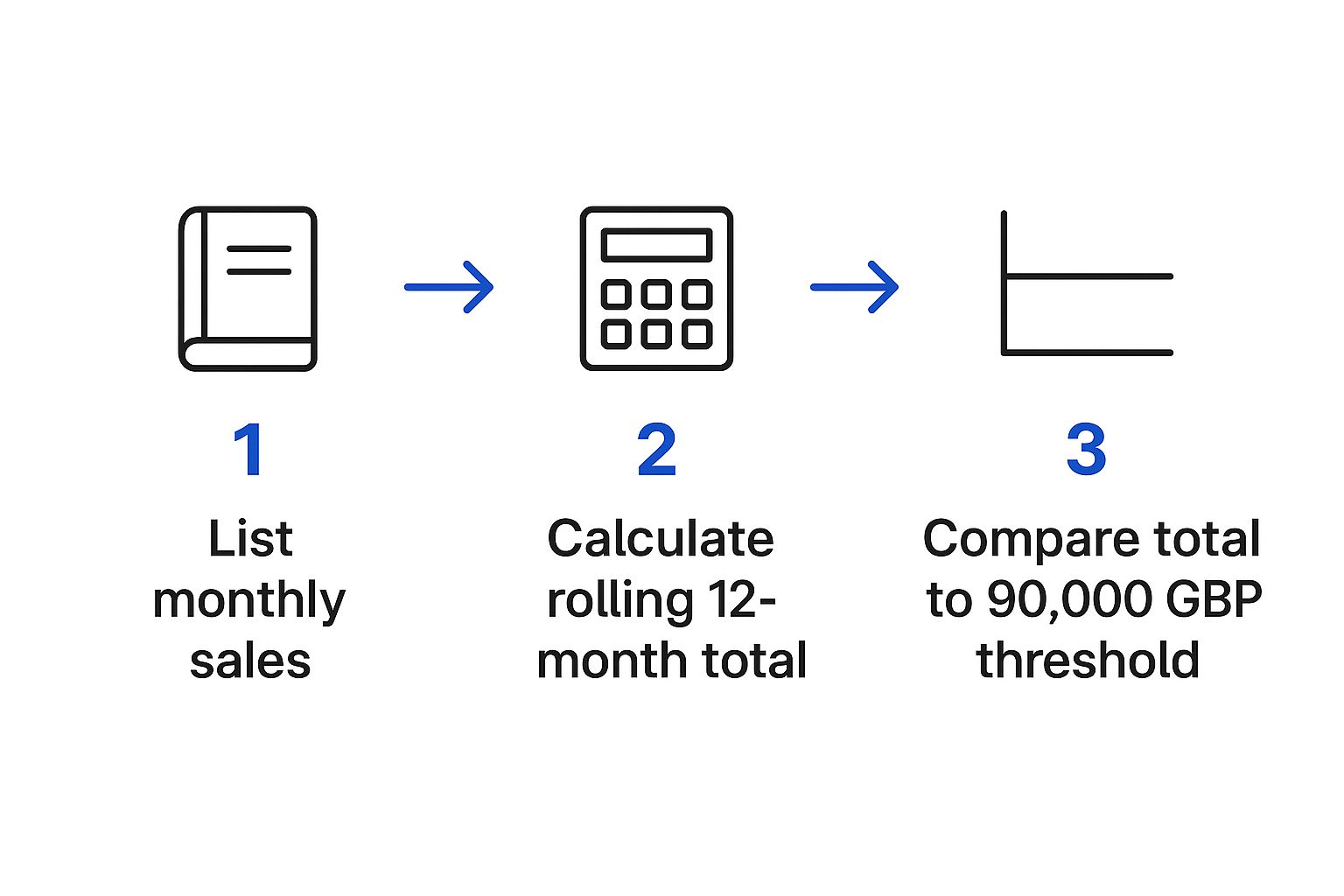
As the infographic shows, this isn’t a job you do once a year. It’s a continuous cycle of monitoring that keeps you in control and ahead of the game.
When the 30-Day Clock Starts
The second your rolling 12-month turnover tips over the £90,000 mark, a very strict deadline kicks in. You have just 30 days from the end of that specific month to get yourself registered for VAT with HMRC. Missing this deadline is a fast track to financial penalties.
By calculating your turnover correctly and consistently, you can see that moment coming and get everything prepared well in advance. No last-minute panic required.
Key Triggers and Deadlines You Cannot Miss

Knowing you’ve crossed the £90,000 threshold is only half the battle. Acting on it promptly is what really keeps your business compliant and penalty-free. There are two distinct triggers for mandatory VAT registration, each with its own strict timeline that you absolutely need to get right.
The most common trigger is the ‘backward look’ test. This is the one we’ve been talking about, where you check your turnover for the past 12 months at the end of every single month. The moment you realise you’ve exceeded £90,000 in that rolling period, the clock starts ticking.
Actionable Insight: If your turnover tipped over the limit on 10th August, you have until 30th September to register. Your effective date of registration (when you must start charging VAT) will be 1st October. Put these dates in your calendar immediately.
Missing this deadline can lead to some painful penalties, so it’s a date you really can’t afford to ignore. A simple but effective habit is to set a recurring monthly reminder to check your rolling turnover.
The Forward Look Test for Large Contracts
The second trigger is the ‘forward look’ test. It’s less common but just as important. This rule comes into play when you have good reason to believe your VAT taxable turnover will shoot past £90,000 in the next 30 days alone.
This isn’t about guesswork or ambitious forecasts. It’s for very specific situations, like when you land a single massive contract or order that will single-handedly push you over the threshold.
Here are a couple of examples to make it clearer:
- A Building Contractor: A small building firm has a turnover of £50,000 so far this year. On 5th June, they sign a confirmed, legally binding contract for a £100,000 extension project that will be completed within the next 30 days. They must register for VAT within 30 days of signing that contract because they know their turnover will exceed the threshold.
- A Wedding Photographer: A photographer has a packed summer schedule. In June, they secure bookings for July that total £15,000, which pushes their rolling 12-month turnover to £92,000. Under the backward look test, they must register by the end of August. The forward look test isn’t needed here because the backward test has already caught it.
It’s easy to think this is all about small businesses, but it’s interesting to note where the bulk of VAT revenue actually comes from. Over 77% of all VAT collected is paid by businesses with turnovers above £10 million. While the £90,000 threshold is a critical hurdle for small businesses to navigate, the wider tax system relies heavily on the big players. You can find more insights on VAT revenue generation on blickrothenberg.com.
Ultimately, whether your turnover grows gradually or you land one game-changing contract, being aware of both triggers ensures you know exactly when the time has come to get VAT registered.
Should You Register for VAT Voluntarily?
While the £90,000 turnover figure is the main trigger for mandatory registration, some businesses choose to get a VAT number long before they hit that mark. Deciding when to become VAT registered isn’t always about legal obligation; sometimes, it’s a smart strategic choice that can offer some serious financial and operational perks.
Voluntary registration means you can start reclaiming VAT on your business expenses right away. Think about all the costs you rack up just to run your business: a new laptop, stock from suppliers, software subscriptions, or even your accountant’s fees. If you’re VAT-registered, you can claim back the 20% VAT you paid on these purchases, which can give your cash flow a powerful boost.
Practical Example: A new coffee shop owner plans to spend £30,000 (+ £6,000 VAT) on an espresso machine and shop fit-out before they even open. By registering for VAT voluntarily from day one, they can reclaim that entire £6,000 from HMRC, providing a vital cash injection for the new business.
Boosting Your Professional Image
Beyond the direct financial benefits, having a VAT registration number can seriously enhance your business’s professional credibility. It sends a clear signal to potential clients, especially larger B2B customers, that your business is established and operating at a certain scale.
For many large companies, being VAT-registered is a non-negotiable requirement for their suppliers. Without a VAT number, you might find yourself automatically shut out from tendering for lucrative contracts, limiting your growth potential before you’ve even got going.
Actionable Insight: Before deciding, analyse your customer base. If 80% of your clients are large, VAT-registered businesses, registering early is likely a smart move as they can reclaim the VAT you charge. If you primarily serve the public (B2C), registering early will simply make you 20% more expensive.
The Drawbacks of Early Registration
However, jumping in early isn’t the right move for every business. The most significant downside is the admin. Once you’re registered, you are legally required to keep digital records and submit quarterly VAT returns to HMRC through the Making Tax Digital (MTD) system. This adds a layer of compliance and paperwork that can be a real time-drain.
Another huge factor to consider is your customer base. If you mainly sell to the general public or to other small businesses that aren’t VAT-registered, adding 20% VAT to your prices will make you more expensive. A £100 service suddenly becomes a £120 service, which could make you less competitive if your rivals aren’t charging VAT. This impact on your pricing is a critical point to weigh up.
To help you decide if it’s the right step for your business, we’ve put together a handy table below and it’s also worth exploring a detailed breakdown of the pros and cons of registering for VAT in the UK.
Voluntary VAT Registration Pros and Cons
| Advantages of Registering | Disadvantages of Registering |
|---|---|
| Reclaim VAT on Purchases: Get back the VAT you pay on business goods and services, improving your cash flow. | Increased Prices for Customers: You must charge VAT, which can make you more expensive for non-VAT registered customers. |
| Enhanced Credibility: A VAT number makes your business look more established and professional. | Administrative Burden: You must submit quarterly VAT returns and comply with Making Tax Digital rules. |
| Access to B2B Markets: Many larger companies will only work with VAT-registered suppliers. | Risk of Penalties: Mistakes on your VAT return or late submissions can lead to fines from HMRC. |
| Pre-Trading VAT Recovery: You can reclaim VAT on costs incurred up to 4 years before you registered. | Complex Rules: VAT regulations can be complicated, potentially requiring professional help. |
Ultimately, the decision to register for VAT voluntarily is a balancing act. You need to weigh the benefit of reclaiming VAT on your purchases and appearing more credible against the added administrative workload and the potential hit to your pricing strategy. Taking a close look at your business model, expenses, and customer profile will help you make the right call.
Navigating VAT Schemes and Special Cases
The standard VAT rules aren’t always a perfect fit for every business. Thankfully, HMRC recognises this. For many smaller businesses, getting your head around the various special cases and simplified schemes can save a huge amount of time, money, and administrative pain.
Knowing about these options is just as important as knowing when you have to register in the first place.
Let’s start with one of the most important exceptions: what happens if you have a temporary spike in turnover? Imagine your business has a brilliant, one-off month and your rolling turnover just nudges over the £90,000 threshold. Panic stations? Not necessarily.
If you can prove to HMRC that this was a blip and your turnover will drop back below the deregistration threshold (£88,000) in the next 12 months, you can apply for an ‘exception’ from registration. This is a practical solution that stops you from getting tangled in the red tape of registering, charging VAT, and then deregistering a few months later. It’s ideal for seasonal businesses or those who land a single, unusually large contract.
Simplified Schemes for Small Businesses
Beyond one-off exceptions, HMRC offers a few schemes designed to make life easier for small businesses. These can drastically cut down on your paperwork, freeing you up to actually run your company.
The two most common choices are:
- The Flat Rate Scheme: Instead of meticulously calculating the VAT on every sale and purchase, you pay a fixed percentage of your total turnover to HMRC. The percentage depends on your industry, making your calculations far simpler.
- The Annual Accounting Scheme: This scheme completely changes your reporting schedule. Instead of filing a VAT return every quarter, you only have to submit one per year. This is perfect for businesses that prefer to handle their major tax admin in one go.
These schemes are all about easing the compliance burden. The Annual Accounting Scheme, for instance, means you only have to prepare and submit one return a year. For a sole trader or a business with limited admin support, that can be an absolute game-changer.
Who Are These Schemes For?
Each scheme has its own rules, but they’re generally aimed at businesses with a smaller turnover. For example, to join the Flat Rate Scheme, your VAT taxable turnover can’t be more than £150,000.
Practical Example: A freelance IT consultant could join the Flat Rate Scheme and apply their industry’s specific rate (say, 14.5%) to their total invoice value (including the 20% VAT). They wouldn’t need to track the VAT on their minimal business expenses, saving hours of bookkeeping every quarter. However, they cannot reclaim VAT on purchases (except for certain capital assets), so it’s best for businesses with low overheads.
Likewise, a small gift shop might choose the Annual Accounting Scheme to line up their VAT submission with their main end-of-year accounts prep. It just consolidates all their financial admin into one, predictable period.
Choosing the right scheme can genuinely offer a pathway to a much simpler tax life.
Life After Your VAT Registration
Getting your VAT number is a big moment for your business. It’s more than just a bit of admin; it fundamentally changes how you manage your finances and invoicing from here on out. Think of this as your practical ‘first 90 days’ plan—designed to turn what can feel like complex new duties into a simple, manageable checklist.
The most immediate change you’ll notice is with your invoicing. From your official registration date, you must issue proper VAT invoices for all taxable goods and services you sell. These aren’t just your old invoices with VAT added on; they need to include specific details like your VAT registration number, the tax point (the date of supply), and a clear breakdown of the net price and VAT for each item. Getting this right is crucial, as your customers need these correctly formatted documents to claim back their own VAT.
Managing Your New Compliance Duties
Next up, you need to get your record-keeping sorted. UK law now requires most VAT-registered businesses to follow Making Tax Digital (MTD) rules. This means you must keep your business records digitally and use MTD-compatible software to file your VAT returns directly with HMRC. Gone are the days of scanned PDFs or simple spreadsheets being enough.
The whole point of this digital system is to cut down on errors and make the process smoother for everyone. Your new operational rhythm will now revolve around submitting quarterly VAT returns. Every three months, you’ll need to:
- Calculate the total VAT you’ve charged your customers (this is your output tax).
- Add up the total VAT you’ve paid on business purchases (your input tax).
- Submit your return online, showing the difference between these two figures.
Paying HMRC or Reclaiming VAT
It’s a simple calculation at the end of the day. If your output tax is more than your input tax, you’ll owe the difference to HMRC. On the flip side, if you’ve paid more VAT on your purchases than you’ve collected from sales—which often happens for businesses making large investments—you can reclaim the difference from HMRC. This results in a welcome VAT refund.
Actionable Insight: As soon as you are registered, create a separate bank account specifically for the VAT you collect. Transfer the VAT portion from every client payment into this account. This prevents you from accidentally spending the money that belongs to HMRC and ensures you always have the funds ready when your VAT bill is due.
It’s also really important to be vigilant about any communications you receive. Make sure you can tell the difference between genuine HMRC correspondence and fraudulent letters or emails. We’ve put together a guide on how to spot scam HMRC letters to help you protect your business.
Frequently Asked Questions About VAT Registration
Even when you think you’ve got a handle on the rules, specific questions always seem to pop up as you get closer to needing to register. Here are some quick, practical answers to the queries we hear most often from business owners wrestling with their VAT obligations.
What Happens if I Register for VAT Late?
This is a big one, and rightly so. Registering late will almost certainly lead to penalties from HMRC. The penalty is a percentage of the VAT you owe, calculated from the day you should have registered to the day you actually did. The longer you leave it, the higher that percentage gets.
The most important thing is to tell HMRC as soon as you realise your mistake. Don’t bury your head in the sand. Being proactive shows it was an honest oversight rather than a deliberate attempt to avoid tax, which can sometimes help reduce the final penalty.
Can I Reclaim VAT on Purchases I Made Before I Registered?
Yes, you can! This is a fantastic and often overlooked perk of becoming VAT registered. HMRC lets you look back and reclaim the VAT on certain things you bought before your official registration date.
There are two simple rules to remember:
- For goods: You can reclaim VAT on goods you bought up to four years ago, as long as you still own and use them in the business.
- For services: You can reclaim VAT on services you bought up to six months before you registered.
A Quick Example in Practice
Let’s say you’re a graphic designer who registered for VAT on 1st July. You could look back and reclaim the £400 VAT you paid on that shiny new high-spec computer you bought back in March (well within the 4-year limit for goods). You could also claim back the £60 VAT from your accounting software subscription you paid for in February (within the 6-month window for services). It’s an instant cash flow boost right when you need it.
Do I Really Need an Accountant to Handle My VAT?
While you’re not legally required to have an accountant, it’s something we strongly recommend. You can absolutely manage your own VAT using MTD-compliant software, but the rules can get fiddly, and the goalposts are always moving.
An accountant doesn’t just save you a huge amount of time; they prevent costly errors and can offer strategic advice on VAT schemes that could save your business a lot of money. For most business owners, the fee is a small price to pay for compliance and complete peace of mind.
Getting your head around VAT registration is a crucial step in making sure your business is compliant and set up for long-term success. At Acorn Business Solutions, we offer a full suite of services to help you manage your business needs efficiently, from company formations and virtual offices to ongoing compliance management. https://acornbusinesssolutions.com
Blog Categories
- Startups
- Sales & Marketing
- Leadership
- Finance & Accounting
- Technology & Innovation
- Customer Experience
- Sustainability & Ethics
- Personal Development
- Success Stories
- Legal & Compliance
- Hiring & HR
- Small Business Tips
- E-Commerce
- Networking
- Acorn Insights
- Industry News
Related Topics
How Do You Redirect Your Mail in the UK?
When you’re moving house or relocating your business, your post is a critical piece of the puzzle. You’ve got two main routes to make sure it follows you: the official Royal Mail Redirection service or a more flexible private mail forwarding service. Which one is right for you? It really boils down to what you
How Do You Redirect Your Mail in the UK?
Moving home? Learn how do you redirect your mail with Royal Mail or private services. A practical guide to costs, setup,
Top accounting courses for small business in the UK (2025)
Discover accounting courses for small business in the UK. Compare top options, pricing, and formats
UK Business Bank Accounts With No credit Checks
Discover UK business bank accounts with no credit checks. This guide explains your options and eligibility
Managing cash flow for small business: Quick tips
Discover managing cash flow for small business with practical steps to forecast, optimize liquidity,
Your Guide to the company unique tax reference number
Discover what the company unique tax reference number is, why you need it, and how to locate yours quickly.

